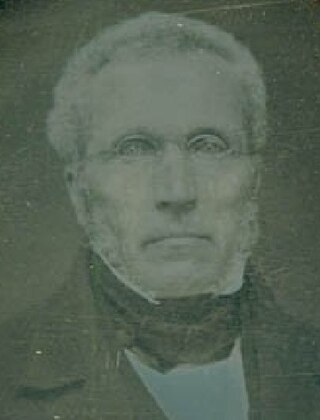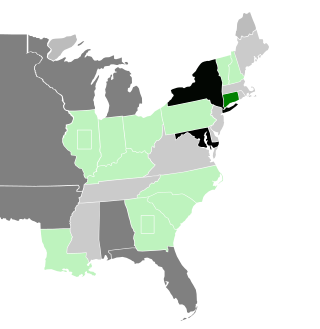Since Alabama became a U.S. state in 1819, it has sent congressional delegations to the United States Senate and United States House of Representatives. Each state elects two senators to serve for six years, and members of the House to two-year terms. Before becoming a state, the Alabama Territory elected a non-voting delegate at-large to Congress from 1818 to 1819.

Vermont has been represented in the United States House of Representatives by a single at-large congressional district since the 1930 census, when the state lost its second seat, obsoleting its 1st and 2nd congressional districts. There were once six districts in Vermont, all of which were eliminated after various censuses.
The 1820–21 United States House of Representatives elections were held on various dates in various states between July 3, 1820, and August 10, 1821. Each state set its own date for its elections to the House of Representatives before the first session of the 17th United States Congress convened on December 3, 1821. They coincided with President James Monroe winning reelection unopposed.
The 1818–19 United States House of Representatives elections were held on various dates in various states between April 26, 1818 and August 12, 1819. Each state set its own date for its elections to the House of Representatives before the first session of the 16th United States Congress convened on December 6, 1819. They occurred during President James Monroe's first term. Also, newly admitted Alabama elected its first representatives in September 1819, increasing the size of the House to 186 seats.

Orsamus Cook Merrill was a U.S. Representative from Vermont.

Richard Walker Mallary was an American businessman and politician. He served for three years as a U.S. Representative from Vermont and was the Republican nominee for United States Senator in 1974, losing narrowly to Patrick Leahy. He died by suicide with terminal prostate cancer on September 27, 2011.

Rollin Carolas Mallary was an American lawyer and politician. He served as U.S. Representative from Vermont.

The 1818–19 United States Senate elections were held on various dates in various states. As these U.S. Senate elections were prior to the ratification of the Seventeenth Amendment in 1913, senators were chosen by state legislatures. Senators were elected over a wide range of time throughout 1818 and 1819, and a seat may have been filled months late or remained vacant due to legislative deadlock. In these elections, terms were up for the senators in Class 3.

The 1818 United States House of Representatives elections in New York were held from April 28 to 30, 1818, to elect 27 U.S. Representatives to represent the State of New York in the United States House of Representatives of the 16th United States Congress.

The 1822 United States House of Representatives elections in New York were held from November 4 to 6, 1822, to elect 34 U.S. Representatives to represent the State of New York in the United States House of Representatives of the 18th United States Congress.
Massachusetts elected its members November 2, 1818. Massachusetts's electoral law required a majority for election, necessitating additional elections in five districts on April 5, 1819, and July 26, 1819.

In 1818, Uriel Holmes (F) of Connecticut's at-large district resigned from the House. A special election was held to fill the resulting vacancy.

During the 15th Congress, there were two special elections in the 6th district of Pennsylvania, both held in the year 1818. The 6th district at that time was a plural district with two seats, both of which became vacant at different times in 1818. The first vacancy was caused by John Ross (DR) resigning on February 24, 1818 and the second was caused by Samuel D. Ingham (DR) resigning July 6.

On April 20, 1818, Jacob Spangler (DR) resigned from Congress, where he'd represented Pennsylvania's 4th district. A special election was held that year to fill the resulting vacancy.

On January 1, 1818, a special election was held in North Carolina's 7th district to fill a vacancy left by the death of Representative-elect Alexander McMillan (F) before the 15th Congress had assembled.

On November 7, 1818, a special election was held in North Carolina's 11th district to fill a vacancy caused by Daniel M. Forney (DR)'s resignation earlier that year.

On February 21, 1818, Representative Peterson Goodwyn (DR) of Virginia's 19th district died in office. A special election was held to fill the resulting vacancy.

Illinois elected its member August 2, 1819, after the new congress began but before the first session convened. The incumbent had just been elected to the new seat in late 1818.
A special election was held in Massachusetts's 20th congressional district on March 16, 1818, to fill a vacancy left by the resignation of Albion K. Parris (DR) on February 3, 1818 after being named a judge of the United States District Court for the District of Maine.

The 1974 United States Senate election in Vermont took place on November 5, 1974. The incumbent Republican Senator, George Aiken, did not run for re-election to another term in the United States Senate. The Democratic nominee, Patrick Leahy, the state's attorney of Chittenden County, defeated Republican nominee, Rep. Richard W. Mallary, to become Aiken's successor. This election also included Liberty Union Party candidate Bernie Sanders, who won 4.1% of the vote.












